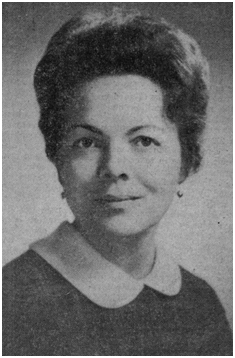 |
Alicia J. Stonebreaker, Artist (1925 - 1976) Alicia Janina Janeska was born in the town of Wieluń in central Poland in 1925. Her parents were Edmund and Stanislawa Janecki. The family owned grocery stores, butcher shops, and houses in and around Wieluń. Alicia began drawing and painting ever since, as a small girl in Poland, she took her sketch pad with her everywhere, “Even when my Father took us for a buggy ride. If I couldn’t find anything else to draw, I’d sketch the back end of our horse. “ Life was pleasant in the Poland of her adolescence. Between World Wars I and II Poland was free for the first time in 100 years. Alicia was in High School when the German invasion took place on September 1, 1939. Wielum was considered to be a thriving economic center and had a large Jewish community. She remembered vividly her family’s attempt to escape the Germans by travelling 800 miles east, almost to the Russian border, only to find the Germans already in place. Returning to Wieluń the Janecki family found their several homes occupied by the Germans and the town heavily bombed. The Wieluń attack was considered one of the first German Luftwaffe actions of World War II. As reported, 1,300 civilians were killed and most of the town was destroyed. |
| The family moved into a Wieluń townhouse and Alicia completed High School under German rule. She was accepted to The Academy of Fine Arts in Poznań, considered as one of the most prestigious fine arts academies in Europe. Her Father was not supportive of her decision to pursue a fine arts career. “He was afraid I would become a starving artist,” Alicia exclaimed, her sister, Krystyna, a Physician, related to her nephew, William. After returning to begin her fourth semester she found the Academy closed because of the threatened Russian invasion. All of the students and professors were rounded up by the Nazis and taken to a concentration camp digging defense ditches. “I didn’t mind the digging,” Alicia said, “but it was terrible to see the older women struggling and dying beside me.” As has happened so many times in her life, in Alicia’s own words, “Luck walked with me.” She was sent 53 KM away from Poznań to Września, Poland. There she was ordered to draw maps for the Germans. Soon, as the Russians were advancing, Alicia and a fellow student, Lena (last name unknown), were allowed to board a train for southern Germany. |
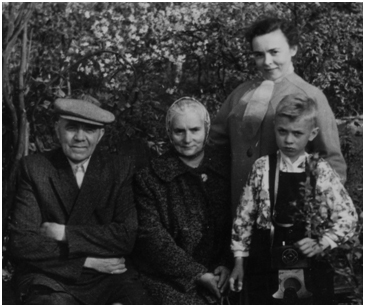 Alicia’s parents, Edmund and Stanislawa Janecki, Sister, Krystyna Kuligowska and son, Rysiu. Summer 1961; Gorzow, Poland |
 Alicia confirmation with Mother and Father beside her, Wieluń 1939 |
They were well aware of the war atrocities being inflicted by the Russians as they advanced on Poland. An elderly gentleman, a professor with his beloved Stradivarius violin, was not permitted to board. At the last moment he handed the violin to Alicia asking her to please safeguard the instrument. She carried it to safety during the three day ride in a crammed open boxcar in late winter. The Stradivarius would bring her more luck. In Germany, Alicia and her friend made their way to the city of Coburg which lies on the Itz River, in the foothills of the Thuringian Forest, some 80 miles (130 km) west of the Czech border. Her friend’s parents journeyed to Coburg and they all lived together, five people in a small room, for the duration of the war. |
| Despite daily alerts, bombings, and scarce food they survived here until the war came to an end. Alicia’s three boys would later remember their Mother telling the stories of how she survived on only potatoes for the last six months of the war. During this time she had no idea what was happening with her family. Alicia finally reunited with many of her family members after the war ended. Her family was close, warm, and loving. It was a family that enjoyed being together and celebrated their holidays, birthdays, confirmations, weddings, and most Friday evenings with large family gatherings. From most photos it is obvious that everyone dressed in their finest clothes and was on their best behavior. They had all experienced, first hand, the horrible ravages of a brutal war and the family was now in recovery mode. Part of Alicia’s family was now in Germany but some remained in their Polish homeland behind the Iron Curtain, now under Russian communist rule. |
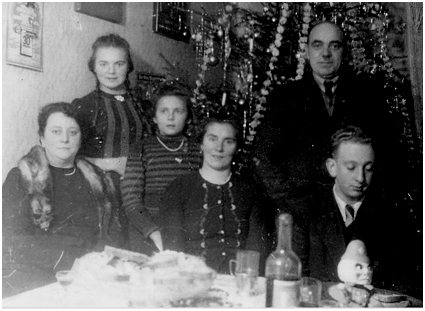 Alicia (17 yrs.) standing, with sister, Mother, Father, and friends, Christmas 1942, Wieluń, Poland |
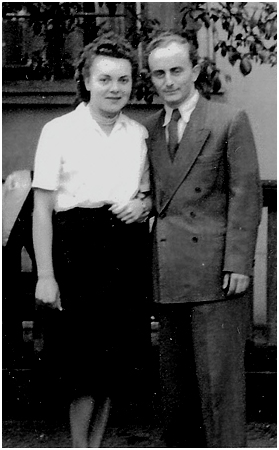 Alicia (26 yrs.) with her Uncle Ari, her Mother’s brother. In June 11, 1951 |
When Alicia learned that the Kassel Art Academy was reopening, she and her friend both applied and were accepted. She was now studying under renowned Professors Niemann, Krueger, and Hayduck. Her instructors were some of the leading art professors of their time in Europe. Alicia was back on track and studying what she loved most. Rooms were impossible to find and Alicia sold her jewelry to pay her expenses. In Kassel, another major turning point in her life occurred when she learned that the professor who trusted her with his violin was a Kassel Orchestra member. They were reunited, and she returned his prized violin. He helped them to secure an apartment and her life began to settle down. Despite her scholarship, after attending for three semesters, Alicia and her friend found it impossible to continue as students after the devaluation of the German Mark. Her friend returned home to Coburg. Alicia worked designing milk carton graphics and lettering the plants milk delivery trucks. As a side job, she designed and painted signs, logos, billboards, and store front windows for many of the business people who were rebuilding after the war. Through a demonstration of her illustration skills she received another big break. She started work at an Armed Forces Base in the American controlled sector of West Germany. They were very impressed with her enormous talent. She began to make a decent living painting signs and sketching charcoal portraits. In 1951, Alicia fell in love with a handsome American Air Force Staff Sergeant, William Clifton Stonebreaker. Her family was heartbroken to see their beloved Alicia leave for the United States. The couple married in Germany and transferred to Eglin Air Force Base in Pensacola, Florida, USA. |
 Born January 1952, William Edmund Stonebreaker, Eglin Air Force Base, Pensaciola, Florida. |
 Alicia on her wedding day, April. 1951 |
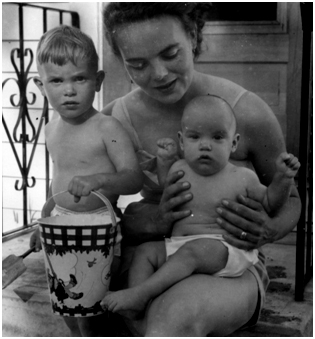 Alicia with her two sons, Billy and Bobby, Bedford, Massachsetts, 1954 |
In 1953 the young Air Force family transferred north to Hanscom Air Force Base located in Bedford, Massachusetts. They rented a small house and she was fully engaged in raising her family. She did not have time for her painting and drawing passion. Their second child, Robert Jerome Stonebreaker, was born on Feb. 12, 1954. Alicia earned her American Citizenship while living in Massachusetts. The couple’s third child, Ronald Gary Stonebreaker, was born on Nov. 22, 1956. In 1959 the family transferred to the Brunswick Naval Air Station in Brunswick, Maine. They lived in the Navy housing apartments at the Air Station until moving off base to an apartment on High Street in Bath, Maine. Their three bedroom apartment was in plain view of the massive Bath Iron Works, the world famous ship builders, on the banks of the Kennebec River. Alicia’s husband received orders from the USAF for a six month deployment to the United States Naval Air Station Keflavik (NASKEF). A former NATO facility at Keflavík International Airport, Iceland. Located on the Reykjanes peninsula on the south-west portion of the island. Their son, Billy, eight years, remembers the pictures his Father sent from Iceland. |
| They showed him and his airmen buddies surf fishing for arctic char all bundled up in USAF winter parkas with fur rimmed hoods. When her husband returned home to Bath the marriage was somehow never the same and lasted until 1961. Alicia now found herself alone in Bath, Maine with the daunting task of raising three boys now age ten, eight, and six. She missed her family dearly in Poland. The bright, young, and talented woman had plenty of incentive to find her way and to make a living. There are no other words to say it, this lady was truly blessed with limitless God given talent to paint, draw, teach, and live life to its fullest. She started to quickly develop contacts and word of her unique talent began to spread. Soon after her divorce she entered and won first place in the Radio Maine “Portrait of Johnny” art contest. Her entry won for best original painting and likeness. Top prize was the Johnny Mathis album, “Portrait of Johnny” and a framed 10 x 12 photo of Johnny Mathis. This did not put food on the table but it was something she knew she could win. Her watercolor and oil seascapes were now being exhibited at the Mckenzie Gallery. Several times a month she began receiving commissions for large oil portraits, private sittings for charcoal and pastel portraits, and paintings of personal homes. More and more frequently one of her paintings would sell at a show. |
 Alicia with sons, l to r, Ronnie,, Bobby, Billy. Bedford, MA; Easter, 1958 |
 Alicia sketching a charcoal portrait at St. John’s Church in Brunswick, Maine |
Her three sons can vividly recall being dragged to every church bazaar, town clam bake, and surrounding lobster festival within fifty miles of Bath, Maine. She would sketch charcoal and pastel portraits over a 12 – 15 hour day. It was common for her to complete 40 – 50 portraits at each sitting. She would display an attractive hand painted sign on an easel that noted, “Charcoal $3, Pastel $5. The likenesses of her portraits and the pace of her sketching was remarkable. There were always five to ten people in line and a swarm standing behind her observing. She learned quickly that one of her top attributes was her ability to teach fine art at every age level. She began teaching at her High Street apartment in one of the larger bedrooms. Classes were held for children Saturday mornings and afternoons, ages 7 to 11, teen classes, beginner and advanced on Wednesday and Friday evenings, with women’s class on Tuesday nights. She instructed a large adult class on Thursday evenings at the Bath Recreation Center. |
| Alicia stated, “I start teaching students with a strong emphasis on drawing,” which she explained is a European approach to fine art instruction. They would do pen and inks, watercolor, oils, and pastels. She would allow all students to try each medium before deciding on their favorite and then have them purchase the necessary materials. She had each student complete one painting at each lesson, from start to finish. “This way their work is fresh and spontaneous,” she explained. Her teenage students started to win prizes at The Young Artists Show at the Mckenzie Gallery. She was extremely proud that many of her students were now exhibiting their works and winning honors in respected art exhibitions around Maine. | 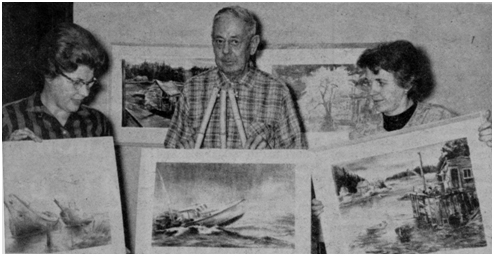 Three of her proud students displaying their artwork |
Her English was rapidly improving and when she would speak, her beautiful Polish accent would be heard. A note found addressed to her students (with her rough sketch of a boy lying on the beach under her typewritten instructions):
|
| Another instructional note explained “The Six Step Figure.” Alicia wrote, “When you want to add a figure (small scale) to a landscape it is not always necessary to do a detailed drawing.” She demonstrated to her students this quick process: 1.) Paint head with one stroke of brush. 2.) Add neck and torso 3.) Add buttocks and breasts 4.) Add upper legs 5.) Add lower legs, feet and arms 6.) When paper is dry, add lips, hair, shadow and any other accents. Her exhaustive energy, pure love and enjoyment of painting and teaching art was irrepressible. Three to four times a week during the beautiful Maine summers her classes would begin at 9:30 am. Everyone would pile into eight or nine cars with their easels, paint boxes, lunches, and fill several old gallon Clorox bottles full of water for painting. They would drive to a scenic location somewhere on Bailey Island, Mere Point, Pemaquid Point, or Harpswell and they would paint all day. |
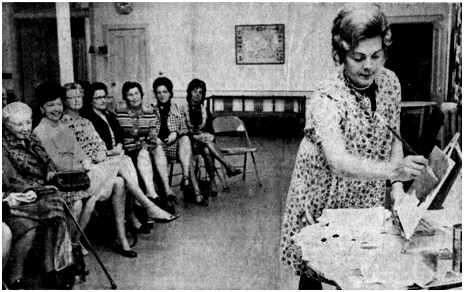 Watercolor demonstration, Lioness Club, Brunswick, Maine 1968 |
She joined the International Toastmistress Club to improve her English grammer and refine her presentation skills. Her education in Poland and Germany focused heavily on the Latin and English languages. She was a true linguist fluent in German, Latin, Russian, and of course, her native Polish language. She was quickly becoming a sought after speaker. Alicia began to share her interesting life and gifts with large audiences. Several times a week she would appear at local fund raising events, Kiwanis, Lions, Elks, and Rotary Clubs. She would speak and then perform demonstrations in oil, acrylic, and watercolors always with an emphasis on drawing. Alicia’s personality was vibrant, energetic, engaging and she was strongly driven in her purpose. She was quickly gaining popularity in the community and was now supporting her three sons, not an easy task. |
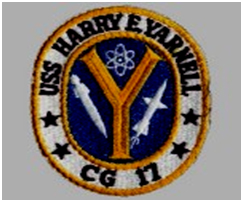 Shoulder patch of the crew of the USS Harry E. Yarnell |
She was always proud of the fact that she never accepted anything for free but worked for everything she had. At this point in her life she was a divorced, driven, young, beautiful, talented, aspiring artist from Poland. The Bath, Maine area is known for its famous shipbuilding heritage. Among the many interesting early opportunities presented to Alicia was a commission by the US Navy to design the shoulder patch for the crew of the USS Harry E. Yarnell (CG 17). Built by the Bath Iron Works the USS HARRY E. YARNELL was the second LEAHY-class guided missile cruiser. The Keel was laid on 31 MAY 1960, launched 09 DEC 1961, and commissioned 02 FEB 1963. |
| Alicia was quickly making many friends and alliances in the Bath area community. In 1962, she realized that to continue growing in her career, Brunswick, Maine was the best place to live and work. She moved her family eight miles south into a second story two bedroom apartment on Boody St. in Brunswick, Maine. The town offered the advantages of having prestigious Bowdoin College and its strong cultural heritage available to her. One of her Brunswick neighbors was Philip C. Beam (1910-2005), Henry Johnson Professor of Art and Archaeology Emeritus at Bowdoin. Professor Beam was a leading authority on the life and works of Winslow Homer and a beloved figure at the College for nearly seven decades. She also met her, soon to be, best friend and mentor at a Bowdoin College instructional demonstration, Mrs. Mathilde Spengler Nixon. |
 Mrs. Mathilde Spengler Nixon (l) with Alicia’s sister, Krystyna ; Brunswick, Maine, 1990. |
| She was the wife of Paul Nixon (1882–1956), who taught classics from 1909-1952, history and Latin at Bowdoin and was named Winkley Professor of Latin Language and Literature in 1946. He also served as dean at Bowdoin from 1918 until 1947. These two people were instrumental in introducing Alicia to the rich fine arts culture that Brunswick, Maine offered. This from a local newspaper report in 1966:
She received a commission from the State of Maine Board of Registration of Medicine to utilize her beautiful calligraphy talent. For years to come she would meticulously hand letter each medical diploma with the name of the soon to graduate physician. Her Father’s concern that she would become a “starving artist” was beginning to fade. Financially, she was now in a position to assist her sister in Poland with her dental career. Boxes of dental equipment were sent to Poland, not available behind the communist Iron Curtain, helping her family begin a successful dental career. |
| Over the next ten years Alicia’s career would flourish and her fame bagan to spread. She was becoming well known throughout New England and was a leading figure in every Maine art circle. Her classes were booked solid with waiting lists of people wanting to learn from her. She soon was making an income that allowed her to purchase the entire house on Boody Street. She quickly converted half of the upstairs into a large studio for her art classes. The other top half remained a two bedroom rental apartment, her family’s first living quarters five years before. Most of her rental tenants were young Navy officers from the Brunswick Naval Air Base or Bowdoin College students. She then extensively remodeled the entire downstairs living area and began to exhibit her sought after oils and watercolor paintings in her newly renovated home. |
 Alicia’s home and 2’nd floor art studio on Boody St., Brunswick, Maine |
| She began summering at Monhegan Island, Maine in 1965 and would paint twenty or more watercolor paintings each summer. Her Monhegan work would sell out within two months of returning from the island. Many times they sold before the paintings were framed and matted. Alicia loved to visit, paint, and relax with friends on Monhegan Island. This is a small and rugged Island ten miles from the nearest mainland and almost a square mile in area. Since long before the explorer John Smith visited in 1614, it was known to Native Americans as a prime fishing area. Today its economy is predominantly made up of hard working Maine people who make their living from lobstering the fertile ocean waters surrounding the island. Artists began to discover Monhegan in 1890 thanks to artist Robert Henri, painter, teacher and founder of Ashcan School of Art, located in New York City. Two of his students, Rockwell Kent and George Bellows were frequent visitors, along with their friend Edward Hopper. Artist Jamie Wyeth’s house on the island was actually built by Rockwell Kent. Joining Jamie were his famous grandfather N.C. Wyeth and his father Andrew Wyeth. Other notable artists included Edward Willis Redfield, Frederick Judd Waugh, Andrew Dasburg, and Maurice Sterne. There were many lesser known, but equally talented painters such as Aaron Berkman, Charles Ebert, Abraham Bogdanove, Michael Lowe, John Hultberg, Tom Boutis, Alex Minewski, Arlene Simon and Mo Oberman. Alicia loved Monhegan’s isolation, the beauty of its wilderness areas, its quiet relaxed atmosphere, and its unhurried pace. Her stunning ability matured as she captured scenes with shade, light, perspective, and most of all her hues of color. Her watercolors began to stand out as her most celebrated work. Alicia spoke with a local news reporter in 1974, “The sea in Maine has been a constantly changing source of inspiration for me. I work outdoors all year around and I don’t have to go very far to find a subject.” Her favorite locale was Maine’s Monhegan Island. |
A letter from Professor Philip C. Beam to the Director of the Moulton Union, Mr. Donovan Lancaster, at Bowdoin College:
|
| The Maine State Legislature contacted her in 1973 and she was awarded a major commission for the portrait of retired Maine Supreme Court Justice Albert Beliveau of Rumford, Maine. Juried Exhibitions, Honors & Awards: • Exhibited at the Farnsworth Art Museum in Rockland, Maine • Won the “Purchase Prize” and “Best In Show” for the top watercolor painting at the Portland Sidewalk Art festival • Her watercolors and oils were exhibited at the Bowdoin Art Museum • Won “Best Of Show” at the Camden Windjammer Festival and sold several of her paintings during the show • Best Watercolor, Bowdoinham Art Show • “Best in Show” watercolor, Bath heritage Days • At the Maine Art Gallery, Wiscasset, Maine she won approval from the eighteen judge panel • Twenty Five works of Alicia exhibited at Harman Hall, Norwich University, Northfield, Vermont, 1972. She was featured in a “News From Norwich” article prior to the exhibit. |
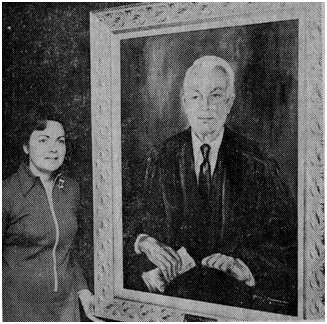 Unveiling of retired Maine Supreme Court Justice Albert Beliveau portrait; Maine State House, Augusta, Maine, 1973 |
| In 1973 she married Vermont District Court Judge John P. Connarn (Norwich '41) and was Alicia Stonebreaker Connarn. The well respected Judge Connarn, Vermont State Attorney General from 1965-1967, loved Alicia dearly. He was a native of Brattleboro and resided nearly all his life in Northfield, Vermont. He graduated from Northfield High School, and he was a Cadet at Norwich University from which he graduated in 1941. After meritorious service in the Eastern Atlantic and Mediterranean Theater in World War II, in which he was severely wounded in France, he earned a law degree from the University of Maine. In 1956, the citizens of Northfield elected this able attorney to represent their town in the House of Representatives where he faithfully served for four terms. In 1967 the General Assembly elected him to a seat on the Vermont District Court, and he presided with great distinction in both district and superior courtrooms until his retirement from the bench in 1985. He remained loyal to his alma mater, serving as president of the Norwich University Alumni Association and as District Captain of the Norwich University 2000 Fund Drive. He greeted guests at the Margaret Holland Inn in Northfield where he was the owner and innkeeper. It was during the 1970 Parents Weekend at Norwich with Alicia’s son, William, in his freshman year where Alicia and John first met at his Margaret Holland Inn. They both travelled to see her family in Poland in 1975. It was her first visit back to her homeland since leaving in 1951. It was a wonderful reunion as she was surrounded again by her Mother, sister, and loving family in Szczecin, Poland. She did find time to paint and brought home two watercolor portraits of her Mother and sister. Her last visit to Monhegan was in June 1975 when she and her husband, John, stayed on the Island for over one month. She painted at a feverish pace with many of these original paintings remaining in the private collections of her sons together with the private collections of Jack and Jean Doyle of Cape Cod, Massachusetts. Her final works were produced in Vermont in late 1976. Her landscapes and winter scenes are stunning examples of her ability to capture the full range of colors and beautiful Vermont landscapes. |
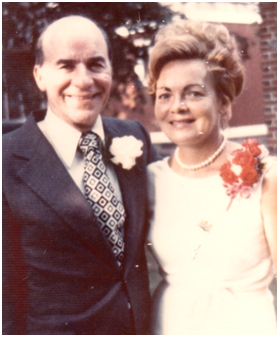 Alicia and Judge John Coonarn on their wedding day; Brunswick, Maine 1973.  Alicia with her nephew Richard, Szczecin, Poland, 1976. |
 “Norwich University, Fall Semester” Watercolor painting original size 24 x 36 |
In the enchanting world of Vermont landscapes, a masterpiece stands out - Alicia Stonebreaker's portrayal of Norwich University in Northfield, Vermont is a sight to behold. Picture this: a vibrant watercolor painted in the crisp October of 1976, capturing the hills adorned with an explosion of colors, while the Norwich Fall Semester was just beginning its journey. The iconic University sits nestled in the valley, with its dorms and classrooms meticulously depicted. As your eyes travel beyond, the town of Northfield emerges in the distance, its church steeple peeking through the lush foliage, adding an air of mystery to the scene. This captivating piece of art was a gift from Alicia to her son, William, an alumnus of Norwich's class of 1974. Little did they know that this painting would become a poignant symbol of love and remembrance. Tragically, Alicia Stonebreaker's brush strokes came to a sudden halt, mirroring her own unexpected departure from this world in that very same month of 1976. Her farewell in Brunswick, Maine was a poignant gathering, with hundreds of friends and family members, including dedicated individuals from the Vermont State Police and Judicial system, coming together to bid farewell to a soul cherished by many. Today, Alicia finds her eternal resting place in the serene Pine Grove Cemetery, nestled close to the Bowdoin College campus in Brunswick, Maine. She leaves behind a legacy carried forward by her three beloved sons - William, Robert, and Ronald. In the tapestry of her life's canvas, Alicia Stonebreaker's brush may have stilled, but her spirit dances gracefully in the memories of those who were touched by her artistry and kindness. |
Our on line Gallery is dedicated to Alicia's love and devotion of painting, drawing, teaching, and her zest for life. She was a devoted Mother and Wife that was loved by many, many people. Together with today’s artwork reproduction technology and Giclée printing, Alicia’s original paintings will become flawless reproductions for everyone to enjoy. "Art Brings Life Into Your World" |

